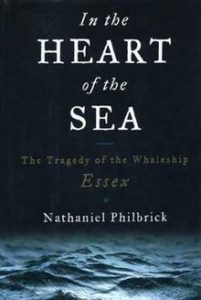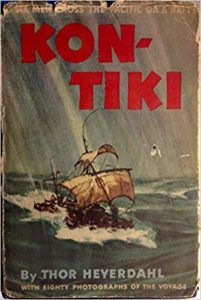
Kate Christensen’s novel The Last Cruise is published this month. She talked with Jane Ciabattari about five true-life stories of gnarly, treacherous, inspiring, and/or dramatic sea voyages.
*

Sea Change: Alone Across the Atlantic in a Wooden Boat by Peter Nichols
A Mile Down: The True Story of a Disastrous Career at Sea by David Vann
These are two absorbing, brilliantly written, endearingly honest memoirs by two highly intelligent but quixotic and stubborn men, each with a romantic idea of life on the sea, each forcefully disabused of those notions during the course of his disastrous voyage by the reality of his own limitations and those of his boat. Weather plays a role, especially in A Mile Down. Things end badly (both boats sink), but each misbegotten voyage happens to have resulted in an excellent book, so we’re the winners here.
Jane Ciabattari: Peter Nichols was headed from Cornwall to Maine, at the end of a stormy marriage; David Vann was trying his hand at being a charter-board captain, haunted by the suicide of his father after he had to give up his dream of being a commercial fisherman. How do these sea voyages mirror the author’s emotional turmoil?
Kate Christensen: Both voyages are the authors’ attempts to make sense of a terrible loss. Nichols’s 27-foot sailboat, Toad, represents all he has on earth in the wake of his divorce—and his ex-wife’s diaries, five volumes in all, happen to be on board with him. As he sails alone across the Atlantic toward Maine, where he hopes to sell the boat, he reads these journals in an effort to understand where his marriage went wrong. The narrative unspools in a riveting double helix of emotional memories and solitude at sea. When the boat springs a leak and sinks, it doesn’t take too much of a leap to see the metaphor here.
Meanwhile, Vann’s boat, first named the Wife of Bath, then the Bird of Paradise, is itself the disaster in A Mile Down. It may be the most cursed boat in the history of literature and/or maritime ventures. In going to sea and trying to stay there, he’s attempting to correct the failure that drove his father to kill himself. And through the book, Vann draws clear parallels between himself and his father, feeling the inescapable pull of father-son destiny in his own determination to keep this accursed, misbegotten thing afloat and sailing at all costs. He manages to survive his own Oedipal quest, just barely, just as Nichols survives his own internal and external Odyssey. And they’re both better for it. These are really books about self-growth through facing challenges of the self-imposed variety.

In the Heart of the Sea: the Tragedy of the Whaleship Essex by Nathaniel Philbrick
An angry, possibly vindictive (anthropomorphically, anyway) sperm whale rams and sinks the eponymous whaleship Essex in this true-life, grueling, chilling survival story that inspired Moby-Dick. The crew spends 90 days drifting in three small lifeboats. The movie was mediocre, but the book is fantastic—riveting, eerie, and impossible to forget.
JC: How would you compare the real-life experience to Moby-Dick? How did Melville shape this story to make it so powerful?
KC: The Essex sank in the middle of the Pacific Ocean, as far from land as it’s possible to get on earth. Years after they’d returned to Nantucket, Melville met and talked to the captain and used his story as a jumping-off point and conceived of the entirely fictional character of Captain Ahab, whose vindictiveness and years-long determination to exact revenge on an attacking sperm whale drives the engine of the novel. Moby-Dick is about one man’s quest to wreak mortal damage on a whale—deliberate, premeditated, (famously) obsessive—along with Biblical themes imagery up the wazoo, whereas In the Heart of the Sea is about the human desire to survive by any means—the thin veneer of civilization and the strength of the human will to live.

Kon-Tiki by Thor Heyerdahl
This classic childhood favorite was my gateway drug to my lifelong love of adventure stories, either disastrous or triumphant. In this case, it’s triumphant. Thor Heyerdahl set off with five other intrepid Scandinavian sailors on a balsa, bamboo, and hemp raft and spent 3 months traveling 4300 nautical miles, attempting to replicate the hypothetical voyage of the early Polynesians from Peru to Polynesia. An amazing, well-told, and wildly inspiring story—especially to a landlocked middle-schooler of Norwegian descent in Phoenix, Arizona in 1973.
JC: I loved Kon-Tiki! As I recall Heyerdahl, a Norwegian, was testing his theory that South Americans populated the Polynesian islands after navigating the Pacific by raft. One of the parts I most remember is the provisions—all that water, in drinking cans and also in bamboo rods, the way it might have been in earlier times. Plus all the fish they caught. And the fact all of this was so foreign to a Scandinavian. Did any particular day or episode stick with you?
KC: So much of that book sticks with me, but the mental image of the Kon-Tiki itself is the clearest thing to me, the improbably beautiful, inexplicably comical raft itself (they all laugh so hard they almost fall into the ocean when they see their raft from their dinghy, and none of them can quite figure out why) with its cozy, well-built, sheltering bamboo and banana leaf cabin, the square Viking sail with Kon-Tiki’s bearded face painted on it, belly-full of trade winds. I also love Heyerdahl’s descriptions of huge, crashing waves just running harmlessly through the logs of the raft back into the ocean, and the way the sea surface was always just right there, a foot and a half under the small balsa log platform they all lived on together for all those months. The Pacific Ocean of Kon-Tiki feels like a live thing, teeming with life, powerful but warm, and for most of their voyage, gentle. The raft and the ocean are the book’s two primary protagonists, and the relationship between them becomes a romantic thing of beauty. It’s such a happy book. Nobody dies, nothing sinks.

Adrift: Seventy-six Days Lost at Sea by Steven Callahan
I love it when the title and subtitle tell the story in a nutshell. After his solo-sailed 21-foot sloop, the Napoleon Solo, sprang a leak right off the Canaries and was swamped in mid-ocean in a gale, possibly after colliding with a whale, Callahan abandoned ship and drifted alone, westward on the trade winds and currents, through the Atlantic Ocean in an inflatable 6-person raft. Callahan’s tale of figuring out how to live for 76 days adrift in the South Atlantic is a riveting, edge-of-the-seat crash course in distilling water, eating sea creatures, mostly mahi-mahi and triggerfish, and dealing with chafing sores and cold, as well as a solitude more profound than almost any other I can think of. He recounts watching enormous tanker ships pass by totally heedless of him as he crossed shipping lanes and reentered the aquatic wilderness. And he describes gazing at the night sky, filled with stars, as “a view of heaven from a seat in hell.”
JC: Adrift was the Atlantic, as opposed to the Pacific. Do you think there’s a difference in difficulty, in location, in survivability?
KC: The North Atlantic sailed by Vann and Nichols is plenty dangerous, but it’s also populated with other ships and Coast Guard helicopters, and land is never so far away. Both the Essex and the Kon-Tiki were in the middle of the uncharted wilderness of the Pacific, so much vaster and emptier of human presence than the Atlantic is. Vann and Nichols both compared their voyages to Greek myths. Heyerdahl was chasing the history and origin of the Polynesians, and the sinking of the Essex and its aftermath feels both Biblical and elemental. But Callahan’s story is a purely human one, the challenge of living in a hostile environment with human ingenuity and intelligence, made even lonelier by the proximity to shipping lanes and home, in a way—it’s much more existential than any of the other books.

